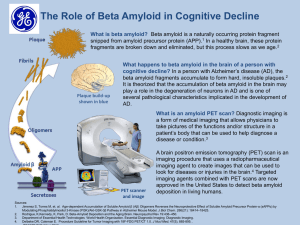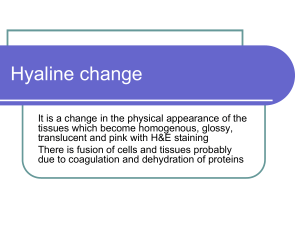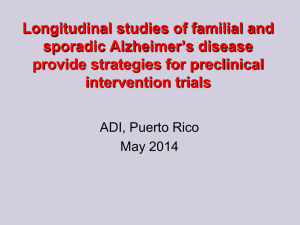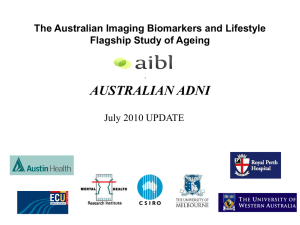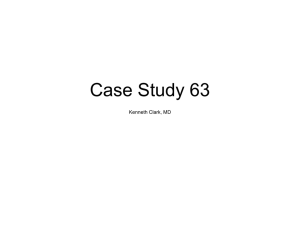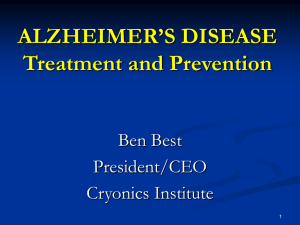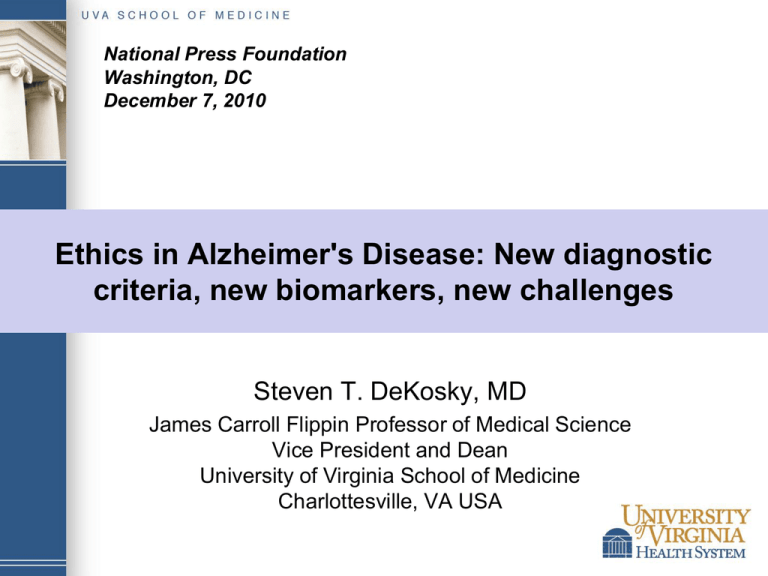
National Press Foundation
Washington, DC
December 7, 2010
Ethics in Alzheimer's Disease: New diagnostic
criteria, new biomarkers, new challenges
Steven T. DeKosky, MD
James Carroll Flippin Professor of Medical Science
Vice President and Dean
University of Virginia School of Medicine
Charlottesville, VA USA
Disclosures
Consultant/Advisory Boards :
Bristol Myers Squibb, Eisai, Lilly, Merck, Novartis,
Pfizer, PsychoGenics
Off-Label Discussion:
– None
Special acknowledgements:
Stephen Post, Stony Brook University
Robert Green, Boston University
Categories of Ethics Questions in
AD (and other late life dementias)
• Moral, cultural and socio-political issues
• Respect and autonomy
– balance of responsibility to individual vs. society, e.g.,
driving privileges
• End of Life Care
– Comfort, feeding, withholding nutrition or water
• Diagnosis and Truthtelling
• The Role of Biomarkers
– Confirmation of Diagnosis, Earlier Diagnosis, Risk
Assessment in Normals
Increasing Global Burden of AD:
Cultures differ in their dealing with dementia
Moral, Cultural, and Socio-Political Issues
• Affirmation of and respect for people with AD and other
disorders involving loss of self (e.g., “deeply forgetful”)
– Example, South Korea efforts to honor people with dementia
– Justice and protection
• Whose responsibility are the Deeply Forgetful? Family?
Society? Government?
– South Korea’s view… all of them
• Respite for family caregivers
– Increased morbidity and mortality
• Ethicists: Cultivate a ‘culture of acceptance’
– The glass is half full (celebrate what is still available to others,
not continue to mourn for what is lost)
Biomarkers
• Diagnostic Confirmation
• Increased Accuracy in MCI
• Risk Assessment in Asymptomatic
People
• What are they? How should they be
used? Research or general availability?
Natural History of
Neurodegenerative Disorders
Preclinical
Symptomatic
Identify cases at earliest time possible
Preclinical Detection: identify
individuals for preventive therapy
Monitor effect of therapy
Time
Model for the progression of loss of neuronal function in neurodegenerative
disorders. There is a prolonged period during which loss of neuronal function has
occurred but symptoms have not yet appeared.
DeKosky ST, Marek K. Science. 2003;302:830-834.
Clinical Ratings
Neuronal Function
Diagnosis Confirm or specify diagnosis
Alzheimer’s Disease: Course,
Prevention, Treatment Strategies
Clinical
State
Normal
Presymptomatic
AD
Mild
Cognitive
Impairment
Disease Progression
AD
Linking Clinical Symptoms With
Degree of Pathology
Intervention
Clinical
State
Brain
Pathologic
State
Primary
Prevention
Presymptomatic
AD
Normal
No Disease
No Symptoms
Early Brain
Changes
No
Symptoms
Secondary
Prevention/
Early Tx
Treatment
Mild
Cognitive
Impairment
AD
AD Brain
Changes
Mild
Symptoms
Mild,
Moderate, or
Severe
Impairment
Disease Progression
Types of Biomarkers
• Genetic
– "Risk alleles" e.g. ApoLiprotein E; APOE
• Biochemical
– CSF Beta amyloid, tau, phosph-tau
• Neuroimaging
– MRI, FDG-PET, amyloid imaging
APOE and Alzheimer’s Disease
ALLELE FREQUENCY:
normal population:
E2
E3
E4
7%
79%
14%
in AD:
7%
40-50%
40-50%
Potential mechanisms:
Impaired removal of beta amyloid
Diminished neural regeneration
Allele frequency twice as high in Africans
& African Americans as in Caucasians
Genetic Biomarkers
• APOE is the major risk gene in AD
• REVEAL study, now 10 years on, has
tracked individuals views and reactions
to have genetic status “revealed.”
• Results benign thus far
• No other genes of near-equal power
are likely to be discovered
REVEAL Conclusions
• Disclosure of APOE does not seem harmful
– may actually reduce anxiety for some who find they are e4-
• Persons alter their LTC insurance purchasing
learning their APOE genotype
– If widespread would have insurance industry implications
• APOE4+ carriers
– more likely to make changes (vitamins, exercise) even
knowing such changes are not proven
– Also more likely to purchase unregulated neutraceuticals
• The impact is less than expected
– people come into the study with a baseline perception of their
own risk
– seem to have a psychological inertia
Structural and Biochemical
Biomarkers
• Biochemical: CSF Beta amyloid, tau,
phosph-tau
– Diagnostic as well as predictive value
• Neuroimaging: MRI, FDG-PET,
amyloid imaging
– Used for diagnostic confirmation in a symptomatic
person, for earlier definitive diagnosis in mild or
uncertain symptoms (e.g., MCI), and for detection
of AD pathology in asymptomatic individuals.
39
Evolution of Neuroimaging in AD
•
•
•
•
•
•
•
Computed Tomography
MRI
Volumetric MRI
Co-registration of MRI
Functional MRI
FDG Glucose PET
Amyloid Imaging
Helmuth L. Science.
2002;297:1260-1262.
www.loni.ucla.edu/~thompson/AD_4D/dynamic.html.
Ethics Issues With Biomarkers
• Diagnostic information
• We can ascertain with high probability
whether AD pathology is present in the
brain
• How much to tell research participants
about unvalidated research results?
Best markers across a broad
range are MRI and FDG-PET
Biomarkers for Earlier Diagnosis
“They stipulate that there must also be at least one or more
abnormal biomarkers among structural neuroimaging with MRI,
molecular neuroimaging with PET, and cerebrospinal fluid
analysis of amyloid β or tau proteins. “
Lancet Neurol 2007; 6: 734–46
CSF in Alzheimer’s Disease:
Low Aβ and High Tau
AD Patients
Control Patients
Concentration (pg/mL)
700
600
500
400
300
200
100
0
Aβ
Sunderland T, et al. JAMA. 2003;289:2094-2103.
Tau
CSF in MCI has
elevated tau,
decreased βamyloid
A combination of CSF T-tau and A42 at
baseline yielded a sensitivity of 95%
and a specificity of 83% for detection
of incipient AD inpatients with MCI.
The relative risk of progression to AD
substantially increased in patients with
MCI who had pathological
concentrations of T-tau and A42 at
baseline (hazard ratio 17·7, p0·0001).
The association between pathological
CSF and progression to Alzheimer’s
disease was much stronger than, and
independent of, established risk
factors including age, sex, education,
APOE genotype, and plasma
homocysteine.
Hansson et al.,2006
Imaging Amyloid in vivo in Humans
• Amyloid Cascade Hypothesis:
– Amyloid deposition begins years before clinical sympto
• Ability to image brain amyloid will impact:
– Diagnosis (sensitivity and specificity TBD)
– Prognosis (different patterns of progression?)
– Monitoring anti-amyloid therapeutic interventions
– Efficiency of drug development
• Current ligands, more in development:
– PiB, AV-45, BF227, FDDNP. Bay compound
• PiB: Now in use in over 40 centers around the world
• F18-PiB in development at both GE and Pittsburgh
– Just as accurate as C11-PiB
PIB PET in AD and Control
PIB Retention
C-8
C-2
1.06
1.64
Distribution Volume Ratio (DVR)
MCI-2
1.04
MCI-10
MCI-4
1.62
Frontal DVR
2.59
AD-2
2.48
Prediction of Outcome Utilizing PiB
Imaging in MCI:
PiB+ Cases Develop AD; PiB- Cases Do Not
23/26 patients have had
follow-up ADRC evaluations
Mean f/u: 24.0 months
(6-57 months)
80%
60%
40%
reverters
stable
converters
20%
0%
13 PiB positive
(Mean f/u: 23.6 months)
10 PiB negative
(Mean f/u: 24.5 months)
Wolk, et al., 2009
-20%
-40%
PiB Positive
PiB Negative
Prevalence of Plaques Precede DAT
Figure 4. Appearance of plaques and DAT
70.00
Amyloid Plaques (Braak & Braak)
Proportion (%)
60.00
50.00
DAT - Average of Three Studies
40.00
30.00
20.00
10.00
0.00
46-50
51-55 56-60
61-65
66-70 71-75
Age (years)
76-80 81-85
86-90
Mean Cortical PIB Binding in Nondemented
Controls and AD (N=41)
1.200
Controls
AD
1.000
scBP
0.800
0.600
0.400
0.200
0.000
-0.200
20 22 23 49 49 51 56 57 58 58 59 59 59 60 60 60 61 61 62 64 64 66 71 72 72 74 75 75 75 76 77 77 77 79 80 81 83 83 84 85 86 86 72 73 73 79 79 81 84 85 86
Subject AGE
Mintun et al, 2006, Neurology
Longitudinal Change in PiB Retention in a
Questionably Positive Control over Two Years
2 yrs
PiB Binding (amyloid plaque density)
in Cognitively Normal Elderly and AD
Aizenstein et al., Arch. Neurol. 2008; 65: 1509-1517
Heterogeneity of Amyloid Binding in
Asymptomatic Normal Elderly
Courtesy of Reisa Sperling, Harvard Univ.
How will disease-modifying
medications affect the field?
• Immediate pressure to identify subjects as
early as possible
• Amyloid scans beginning at age 50,
repeated every 5 years, as for colon
cancer
• Public Health Message: “At 50, get
evaluated head to tail! Have your
colonoscopy and your PiB Scan.”
Operational Research Criteria
for Preclinical AD
• Not intended as clinical diagnostic criteria
• Prognostic utility of these biomarkers in
individual subjects remains unclear
• Not all individuals with neuroimaging
evidence of AD changes will develop
clinical symptoms during life
– 30% of non-demented 80+ year olds have
evidence of AD in the brain at autopsy


